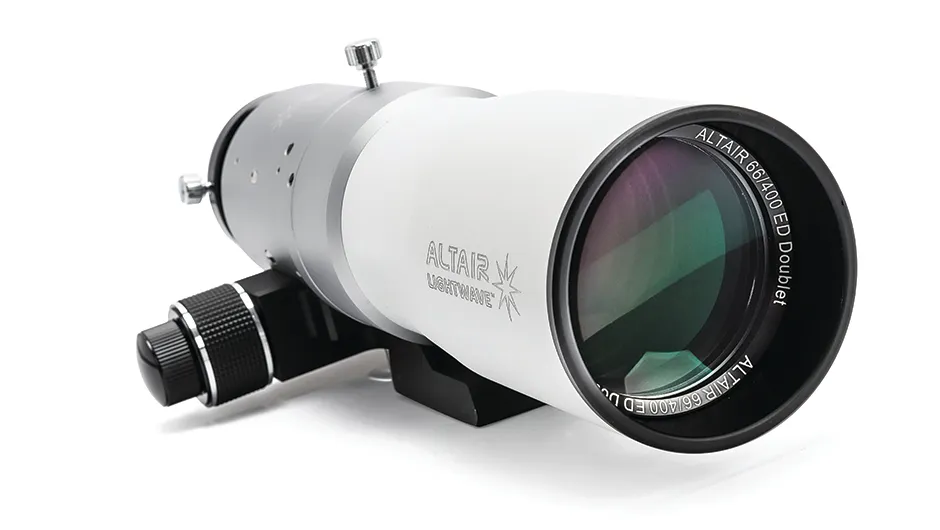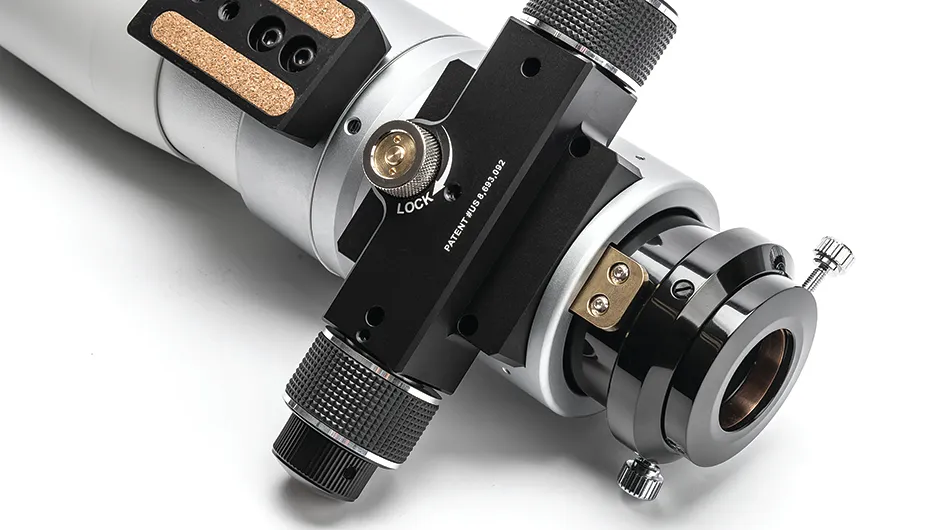Small refractors such as Altair’s Lightwave 66ED-R may give the impression that you won’t get to see much due to their diminutive size, but don’t let that fool you.
Instruments like this one perform far better than the classic 60mm achromats that beginners traditionally start off with.
As we discovered, the Lightwave 66ED-R packs some punch.
This refractor is supplied as a basic package comprising only the telescope tube, which is fitted with a 2-inch dual-speed rack and pinion focuser (this is what the R stands for in ED-R), a retractable dew shield, hard aluminium carry case and a 2- to 1.25-inch adaptor with brass compression rings.
For visual use you will need to add a star diagonal and a selection of eyepieces; for DSLR astrophotography, you will also need a T-ring and nosepiece.
We used our own dielectric star diagonal, 26mm and 10mm eyepieces, plus 2x Barlow and 5x Powermate lenses for our tests. Viewing the bright star Regulus in Leo with the 26mm eyepiece gave a magnification of 15x and a wide field of view covering just over 3°.
This meant that when we turned to the constellation of Lyra, the Harp, we could fit both Beta and Gamma Lyrae in the view with room to spare.
The viewing quality was good, with Regulus pin sharp across 90 per cent of the field and only a slight degradation towards the field edge.
Colour aberration was also well controlled, with only the slightest fringing on bright stars when the magnification was pushed beyond 100x.

Pushing the magnification
Altair Astro suggests that the theoretical maximum magnification is 133x using a 3mm eyepiece, however using a 10mm eyepiece and 5x Powermate to give the equivalent of a 2mm eyepiece (200x magnification) we could split Epsilon Lyrae, the ‘Double Double’, into its four constituent stars and the view was just acceptable.
Indeed double stars were a treat in this scope and there is a huge range of them within its reach, including Albireo (Beta Cygni), 17 Cygni and Nu Draconis.
With low magnification many will look like a single star, but push the magnification up and you will be rewarded with great views.
Deep-sky observing is a mixed bag due to the wide field of view at low magnification, but using a 26mm eyepiece we could spot most of the brighter deep-sky objects in the Messier and Caldwell catalogues.
The galaxy pair of M81 and M82 in Ursa Major were lovely smudges, with the thin, side-on view of M82 apparent.
Adding our 2x Barlow improved the view.
Large objects such as Melotte 111 in Coma Berenices and the Beehive Cluster in Cancer fared better at low magnification, giving pleasing views.
The star fields of Scutum were just coming into view for us and we did enjoy sweeping the Milky Way when we attached the scope to a photo tripod for ease of use.
Due to the wide field of view, the Moon and planets appeared small through the 26mm eyepiece, but due to the quality of the optics we could push the magnification to explore the cratered landscape of the Moon and spot the two main belts on Jupiter, along with the four Galilean moons.
Despite being small, Saturn was crisp, and again high magnification allowed us to glimpse the Cassini Division, a hint of a belt on the planet and several of its brighter moons.
Attaching our modified Canon EOS 300D DSLR with its APS-C sized sensor allowed us to image the nebulosity around the star Sadr in Cygnus.
We took 22 images, each exposure lasting two minutes, at ISO 800, then stacked and processed them to bring out the nebulosity.
The results were pleasing, but did show the typical effect of distorted stars towards the field edges.
A field flattener would be useful for wide field imaging – adding one of our own, plus a hydrogen-alpha filter, revealed sharp stars to the edges in an image of the Veil Nebula Complex.
The Lightwave 66ED-R is a small, yet versatile refractor that can act as a grab and go, wide-field visual or imaging scope, or even be pressed into service as a guidescope or for viewing the Sun in hydrogen-alpha light.

Altair Astro Lightwave 66ED-R as a solar telescope
The Lightwave 66ED-R is a good all-rounder and ideal for grab and go observing.
However, beyond the night sky, this scope could be used with a DayStar Quark eyepiece filter to view the Sun in hydrogen-alpha light.
Being a small instrument, the 66ED-R does not require an energy rejection filter – they are only needed for instruments with a lens diameter larger than 3 inches.
We were able to borrow a Quark Chromosphere eyepiece filter and used it with the 66ED-R for both observing and imaging: it gave impressive views of our star.
With our 26mm eyepiece inserted we could view the whole of the solar disc, including prominences and surface detail.
It is yet another string to the bow of this versatile instrument.
Altair Astro Lightwave 66ED-R: 5 best features
1
Focuser
The dual-speed rack and pinion focuser can be rotated, which makes it easier to frame an image in a camera, and has a locking screw to hold it tight.Underneath lies another locking bolt that enables you to lock the focus position when attaching a camera.It has a generous 97mm of focus travel.
2
Dew shield
The retractable dew shield was smooth to use and still easy to retract for storage, although there was no thumbscrew to secure it in place.However, friction appeared to keep the dew shield extended throughout our review period, and it gave good protection from dewing up under slightly damp conditions.
3
Mounting
The Lightwave 66ED-R has an L-shaped mounting bracket consisting of a dovetail-style foot to fit most telescope mounts with Synta- or Vixen-style mount heads.Under the base there is also a 1/4-inch photo tripod thread for fixing the telescope to a standard photographic tripod.
4
Internal baffles
Internal reflections can spoil the contrast in faint deep-sky objects, so it is good to see the internal baffles and inner tube surface are matt coated to cut down on any stray light bouncing around inside the tube.
5
Optics
The 66mm, f/6 optics are a doublet arrangement composed of Ohara ED (extra-low dispersion) glass elements, giving good colour correction.All air-facing surfaces are coated with super-high transmission coatings, which helps to improve contrast.
Vital stats
Price: £329.00
Aperture: 66mm
Focal Length: 400mm (f/6)
Weight: 2kg
Supplier: Altair Astro
Telephone: 01263 731505
Website:www.altairastro.com
This review originally appeared in the August 2015 issue of BBC Sky at Night Magazine.

